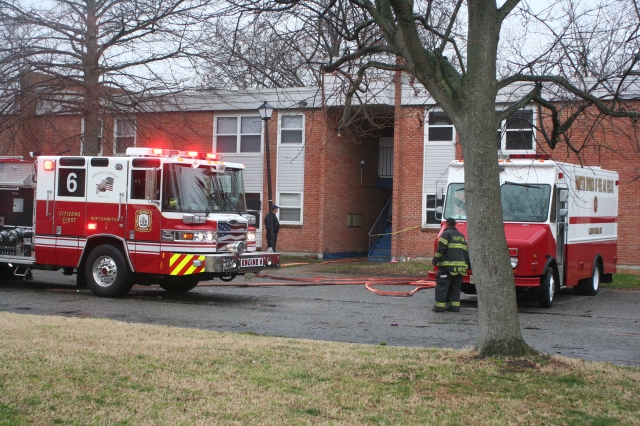Daily Press Watchdog report, Feb 19, 2012
By David Macaulay

The owners of a run-down apartment complex in Hampton faced possible default on a loan before the city bought the property and paid off the debt. Tipped off about serious conditions at Harbor Square apartments in downtown Hampton, the Virginia Housing and Development Authority served notice on its former owners saying they would be in default on a $12.6 million loan if a plan of improvement was not made. The state housing authority gave Olde Towne Associates LLC 15 days to come up with a plan to remedy the situation or face default.
That notice came Nov. 10, 2011, less than a month before the city of Hampton purchased the property for $13.4 million, according to documents obtained by the Daily Press under the Freedom of Information Act. A portion of a $6.5 million loan made by the VHDA in 2000 to the Harbor Square owners – $1.85 million – was to make improvements at the 368-unit complex.
Ten years later the complex was deteriorating and in serious need of repairs. Olde Towne took out an additional loan of $8 million in 2005. The city maintains it was not aware of the full extent of the problems at the apartment complex when, in a 4-2 vote in August 2011, the Hampton City Council decided to buy Harbor Square.
It wasn’t until the city was allowed in for pre-purchase inspections that the extent of the problems became known. Conditions found at Harbor Square included failing roofs, black mold, flaking asbestos, lead paint and structural problems on stairways, according to Hampton city inspection reports. As part of the $13.4 million purchase of the crime-ridden complex, the city assumed the VHDA loan and announced it would raze the property. The former owners walked away and the city’s taxpayers picked up the tab as well as the responsibility for $12.6 million in loans.
THE VIOLATION LETTER
The VHDA in its Nov. 10 letter cited the original deed of trust made on Jan. 31, 2000, and referred to Olde Towne’s “failure to operate, or cause the development to be managed and operated in all respects in a manner satisfactory to the authority.” It said Olde Towne was in violation of the original loan documents because it had failed to maintain Harbor Square in a “clean, attractive, safe and sanitary condition.”
Neal Rogers, a manager of asset management with the VHDA, wrote to Aubrey Layne, president of Olde Towne Associates and Great Atlantic Real Estate-Property Management. In the letter Rogers cited “numerous deficiencies in the physical condition of the development.”
The letter said the owners had failed to restore, repair or rebuild structures, had permitted the deterioration of the property and created conditions that rendered it less valuable or marketable. The authority gave Olde Towne 15 days to produce a plan to correct the deficiencies to its satisfaction, or it would declare a default. “If the owner does not produce a plan that will correct the deficiencies … identified on the attached exhibits in a timely manner appropriate to the type of the deficiency to the satisfaction of the authority within 15 days after the date of this notice, then without further notice the authority shall declare a default under the regulatory agreement and deed of trust,” the letter from Rogers stated.
Contacted on Jan. 23 Layne said he had “no interest” in answering questions about Harbor Square. Questions emailed to him from the Daily Press went unanswered.
The letter refers to the original deed of trust which said in the event of default the full debt would “become at once due and payable.” The deed said in the event of a default, the property would be sold at an auction for cash.
An auction never happened because the city stepped in via the Hampton Redevelopment and Housing Authority. “City officials considered several strategies once the decision was reached to purchase the Harbor Square property and convert it to usage consistent with the citizen-led Downtown Master Plan,” said city spokeswoman Robin McCormick.
“The goal was to acquire the property quickly and at the lowest possible cost,” she said. “Risking legal delays, uncertain outcomes and a bidding war with at least one known competing purchaser would not have been prudent.”
Another bidder, the Merrimac Group, was interested in buying Harbor Square to rehab it. Last month, Tim Slagle of the Merrimac Group said he believed it was possible but not certain the price would have been lower at an auction without the burden of a loan. Several city officials were “aware VHDA was considering serving a notice” on the owners of the complex, McCormick said.
THE BACK STORY
The city agreed to purchase Harbor Square for $14.5 million in August 2011, subject to inspections. At the time, city officials said Harbor Square was crime ridden, deteriorating and that the troubled apartment complex did not fit in with the overall master plan for downtown Hampton.
The city’s housing authority was only able to inspect rentals of apartments leased by Section 8 tenants. City code inspectors were able to inspect the outside of properties but do not have a legal right to enter units not leased under Section 8. After they entered into a purchase agreement with Olde Towne, inspectors found substandard living conditions, and based on those inspections, the city came back with a lower price for the complex and cited a plan to raze the entire development.
On Nov. 21, 2011, Hampton City Manager Mary Bunting said the city agreed to buy Harbor Square for $13.4 million assuming the $12.6 million VHDA loan as well as a sum to cover some outstanding bills. The loan had been reduced to $12.6 million because of monthly payments on the principal and interest, according to the VHDA. Bunting said Olde Towne Associates LLC, would receive no income or profit from the sale.
An agreement with VHDA assured Hampton that the state would waive a penalty for payoff of the loan before 2015. The Hampton Redevelopment and Housing Authority closed on the property for $13.4 million on Nov. 30. On Dec. 22, the Hampton City Council voted 4-2 to pay off the VHDA loan.
Councilmen Ross Kearney and Donnie Tuck dissented. Unhappiness about citizens footing the bill for the poor state of Harbor Square was expressed by Kearney, a former Hampton mayor, at the Dec. 14, 2011, City Council meeting.
Kearney had previously backed the purchase but changed his vote in a resolution to pay off the loan. “We’ve got here a situation where we have a piece of property that has been allowed to deteriorate over a number of years to the point where it is sickening to all those involved who went in and inspected it,” Kearney said.
He estimated the price paid by the city of Hampton was inflated by about $5 million and that the planned demolition would cost about $2 million. “We are dealing with a group that actually went to the VHDA and got a loan of over $8 million based on Harbor Square and never put the money into it,” Kearney said.
“It’s like they got a home equity loan to send their kids to college and none of them went and they still had the money so they did other things with it.” Hampton Mayor Molly Ward and some of her relatives are beneficiaries of the trust that owned the complex. Olde Towne Associates LLC was largely owned by Great Atlantic.
Declaring an interest as a “passive beneficiary” of a trust created by her father’s will, Ward did not take part in any city deliberations or votes on Harbor Square. In a press release last November, McCormick, the city spokeswoman, explained the mayor’s role. “That stake has passed to a family trust that includes Hampton Mayor Molly Ward and other family members as beneficiaries who are not authorized to manage the property or make business decisions for the trust.”
The original $6.5 million loan taken out in 2000 included a sum of $1.85 million that was to be used for repairs and held in escrow for that purpose. Olde Towne Associates took out an additional loan of $8 million with the VHDA in 2005, according to VHDA documents. The second loan did not contain a repair clause.
Documents disclosed under the Freedom of Information Act reveal the original mortgage was subject to a receipt from Olde Towne and acceptance by VHDA of a plan to replace all roofs, HVAC equipment, windows, parking areas, Dumpster pads, sub metering and plumbing lines.
In a Feb. 1, 2000, letter to Layne sent to Olde Towne at the offices of the Great Atlantic management company, E. Bennett Atwill, a development officer with the VHDA, said the authority was not satisfied with the level of detail provided by the borrower as to the scope of work and did not consider the special condition of the mortgage was met.
However, Atwill said the VHDA would agree to proceed to closing on the loan as long as work samples were provided before the work was carried out. Judson McKellar, an attorney for the VHDA, said all of the $1.85 million was used by Olde Towne.
The VHDA produced receipts showing roof replacements and replacements of items such as HVAC systems carried out in 2000 and 2001. By the start of 2011, evidence of the deterioration of the complex, is apparent in correspondence between Layne and the VHDA. On Jan. 20, 2011 Layne wrote of monthly deficits and the need to replace two roofs at the cost of $40,000.
A workout agreement was discussed between Layne and the VHDA to help finance repairs in February 2011. In October 2011, a condition report carried out by the city of Hampton revealed serious problems including bad drainage of roofs.
“The lack of roof drainage and damaged/worn roofing membrane is causing widespread damage, via water infiltration, to the interior surfaces of the apartment building,” the condition report stated. In his Nov. 10 letter to Olde Towne, Rogers of the VHDA said the owner “ultimately declined the terms of the workout agreement.”
ASBESTOS ISSUES
There were other problems at the apartment complex that were highlighted in the 1990s. A letter from the VHDA to Layne sent on Jan. 27, 2000, suggested asbestos at the complex should be abated.
Atwill said Olde Towne should maintain an asbestos program prepared in 1996 by Drucker and Falk Properties. Failure to do so would have been considered a default under the loan documents. Drucker and Falk had identified tile mastic under some kitchen and parquet floors as an “area of the building where highly friable asbestos materials are present.” Friable asbestos is considered the most dangerous type because it can become airborne and lead to a form of lung cancer called mesothelioma.
The report said floors should be capsulated. The city’s inspection in October 2011 concluded: “Asbestos may be exposed in areas where flooring is damaged or missing.” “Asbestos removal was not included in the scope of work approved by VHDA,” McKellar said in an email.
Brian Matt, a spokesman for VHDA, said upgrades to the floors were part of work handled over a four-year period from 2000. “This scope did not call for the removal of asbestos flooring,” Matt said. “Common practice would have included overlaying the floors with luan underlayment and covering them with sheet vinyl. This approach would have prevented any asbestos tile from being abraded and becoming friable.”
INSPECTING THE UNITS
Building permits highlight a large number of problems at Harbor Square going back at least a decade. The city of Hampton has maintained it was not aware of the extent of the problems inside apartments until it entered the due diligence period in the fall of 2011.
It entered a “fully executed agreement” to buy Harbor Square on July 27, 2011, but a council vote to proceed to buy in August, in which Donnie Tuck and Angela Leary voted no, was subject to due diligence. “We did not have access to the interiors of the apartments,” City Manager Mary Bunting said at a council meeting on Dec. 22, 2011.
She was referring to city codes compliance officers who she said could only deal with exterior issues. But inspectors with the Hampton Redevelopment and Housing Authority were routinely granted access to inspect the interiors of units occupied by Section 8 tenants.
The inspection reports obtained under the Freedom of Information Act show that 373 inspections were carried out in 2011. In total, 200 apartments failed and 119 passed. Inspection failures include water damage to parquet floors. The glue under parquet floors was identified as an area where asbestos was present in the 1996 report. “City and HRHA officials knew the condition of the Section 8 units due to those inspections and also knew that deficiencies were being corrected,” McCormick said.
“Building permits would also indicate that, while there were problems, repairs were being made,” she said.
OTHER PROBLEMS
“What the city didn’t know until it began due diligence for the purchase was that the two-thirds of the units we were not able to inspect were in worse condition – sometimes significantly worse – than the units under the HRHA inspection program,” said McCormick, the city spokeswoman.
“At that point,” she said, “concern for the safety and care of residents added to the need for an expeditious sale.” Building permits on Harbor Square are also held by the city of Hampton. On May 5, 2011, a contractor reported a caller said her apartment had been full of black mold for three months and the ceiling had collapsed.
Another ceiling collapse was reported in May 2010. The resident said mold and mushrooms were growing in her apartment and her children had respiratory illnesses.
A rat infestation was reported in an apartment in 2007 as well as broken pipes that were leaking. In the same year, one resident said her daughter was getting headaches from the mold build up.
Water running down walls and a floor caving in were reported in 2006. In July 2000, an inspection said a roof “was not properly repaired” and caused water damage in an apartment. Layne, representing Old Towne Associates, would not comment for this report. But McKellar with the VHDA said that with the sale of the property, the company is no longer obligated to the state or the city for making any repairs at Harbor Square.
“The owner of the development no longer has any contractual obligation to VHDA under the loan documents for making repairs to the development,” he said. In an effort to close down and raze the complex as quickly as possible, the city has offered relocation assistance and financial incentives to Harbor Square residents. Earlier this month, almost seven of every 10 apartments had been vacated.
THE PROPERTY
*An 18-acre, 368-unit complex of garden-style apartments located near downtown Hampton. *Built in 1969.
*The apartments housed many residents who receive Section 8 subsidized housing, but there were also market-rate units.
*Hampton officials say the complex is not compatible with the city’s master plan, which calls for streets to be extended through the area and higher-value housing and public spaces. A new Circuit Court and parking are also planned.
THE CONDITIONS
*Inspection reports obtained by the Daily Press revealed numerous problems including asbestos, mold, lead-based paint, roaches, stairways that were rusting and failing, a broken sanitary sewer system, and furnaces leaking exhaust directly into units.
The city estimated it would cost $4.5 million to $5 million to repair Harbor Square. *Interviews with residents, who spoke to the Daily Press on the record, highlighted problems with mosquitoes, trash, damp, sagging ceilings, malfunctioning heating systems, broken sinks and a large hole in the wall of one apartment.
THE MONEY
*The City of Hampton purchased Harbor Square for $13.4 million assuming a $12.6 million Virginia Housing Development Authority loan made to the previous owner, Olde Towne Associates LLC.
*Olde Towne received a $6.5 million loan from the VHDA in 2000, $1.85 million of which was to make improvements. Olde Towne took out an additional loan of $8 million in 2005. *The property has been assessed at $17.18 million with buildings on it
WHO’S INVOLVED
The City of Hampton: The city purchased Harbor Square, with plans to demolish the buildings and redevelop the land. Olde Towne Associates LLC: Former owners acquired the property in 2000. Hampton Mayor Molly Ward and some of her relatives are beneficiaries of the trust. Ward has removed herself from related discussion and votes. VHDA: Nonprofit organization dedicated to helping people find affordable housing. It provides mortgages and other services. It was created by the Commonwealth, but doesn’t use taxpayer money.
DEEDS OF OWNERSHIP 1969: Land owned by the Hampton Redevelopment and Housing Authority is sold to Albert T. Brout for $122,455 for the building of an apartment complex “to prevent recurrence of blight.” 2000: Harbor Square is sold to Olde Towne Associates LLC in January 2000 by Thora Brout Pollak (daughter of Albert T. Brout), who had 90 percent ownership and Edwin A. Joseph II, who had 10 percent ownership. 2011: Hampton Redevelopment and Housing Authority purchases the property for $13.4 million. Sources: VHDA documents, and Joseph v. Pollak (1992 U.S. District Court)
WHO IS OLDE TOWNE ASSOCIATES? Hampton Mayor Molly Joseph Ward has said she had no influence over the trust. “I have no authority or control whatsoever with regards to my ownership interest,” Ward said in an email to the Daily Press. In 2005, the Virginia State Corporation Commission listed six trusts or individuals as comprising Olde Towne Associates: * Joseph Asset Management * the Antonia Lawn Joseph Trust * the Mariella Joseph Trust * Pal Investments LLC * Harbor Square Manager Inc. * George B. Joseph Three of the names match those found as surviving children in the obituary of Edwin Joseph, who died in December 2005. Sources: Virginia State Corporation Commission and Daily Press Archives












